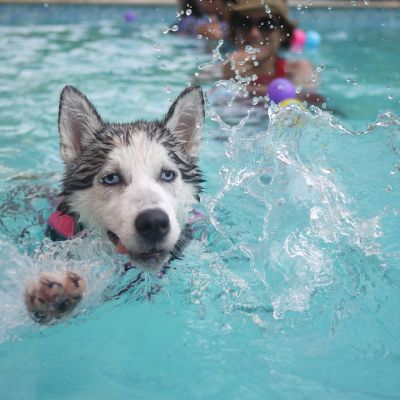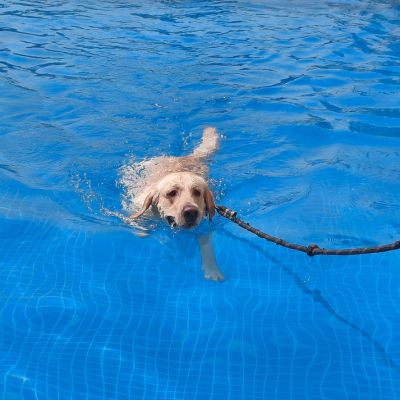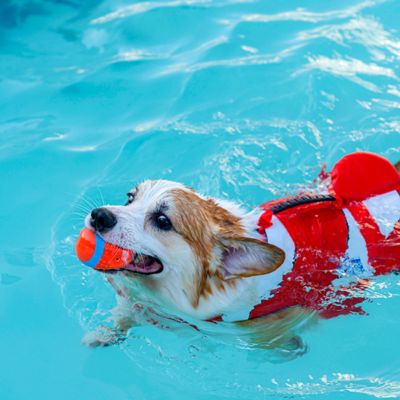Dogs are often seen happily paddling in water, but many pet owners wonder, “Can dogs naturally swim?” The answer isn’t a simple yes or no. Some breeds are great swimmers by instinct, while others might have trouble or even be unsafe around water.
Knowing your dog’s breed, body type, and personality is important to keep them safe and enjoy water fun.
A dog’s confidence in water is shaped by early experiences, not just genetics.

Do all dogs have natural swimming ability?
Most dogs can do a basic “dog paddle” when they’re in water, which is a natural movement that helps them stay afloat. But just because they can paddle doesn’t mean they’re good swimmers. Some dogs are more comfortable and confident in water, while others may struggle or tire quickly.
A dog’s ability to swim depends on its breed, body structure, and physical fitness. Some breeds are built for swimming and love the water, while others might find it more challenging. It’s important to know your dog’s abilities and make sure they’re safe around water.
Understand how my dog enzo learned to swim
Last week, I took Enzo for his first swimming session. At first, he was a bit unsure and hesitant when he stepped into the water. He paused, looked around, and took a few careful steps. But with the trainer’s guidance and some encouragement, he slowly began to paddle. It didn’t take long for him to get comfortable. Once he found his rhythm, he started moving around the pool with ease. By the end of the session, Enzo looked confident and happy. It was clear he enjoyed the experience, and now swimming is something he looks forward to.
Here is the video of Enzo’s first swimming session:
Which dog breeds are natural swimmers?
Some dogs are known to be natural swimmers due to their history of water-based work, such as retrieving waterfowl or performing water rescues. These breeds often have physical adaptations for swimming:
- Labrador Retriever – Labradors are one of the most popular breeds and are excellent swimmers. Originally bred to retrieve fishing nets and catch waterfowl, their webbed feet and strong limbs make them natural water lovers.
- Golden Retriever – Golden Retrievers share similar traits to Labradors and are known for their stamina in the water. Their love for swimming and retrieving make them perfect companions for water activities.
- Newfoundland – Newfoundlands are large dogs with a thick, water-resistant coat and webbed paws, making them superb water rescuers. They were originally bred to pull nets for fishermen and rescue people in distress.
- Portuguese Water Dog – With a history of herding fish and pulling nets for fishermen, these agile and strong swimmers have a curly coat that repels water, making them comfortable in aquatic environments.
- Standard Poodle – Despite their elegant appearance, Standard Poodles were originally bred for waterfowl hunting. Their curly coats help keep them warm and dry while swimming, and they excel in the water.
- Chesapeake Bay Retriever – Known for their incredible swimming ability, Chesapeake Bay Retrievers were bred to retrieve waterfowl in tough conditions. They have a dense, waterproof coat and strong, muscular bodies that make them great swimmers.
- Irish Water Spaniel – This curly-coated breed is known for its love of water. Irish Water Spaniels are agile and strong swimmers, often used for retrieving waterfowl and working in challenging water conditions.
- Curly-Coated Retriever – Curly-Coated Retrievers are one of the oldest retriever breeds and are fantastic swimmers. Their curly, waterproof coat helps them stay warm in cold water, and they are skilled at retrieving in the water.
- American Water Spaniel – This versatile hunting breed was developed to retrieve game from both land and water. Known for their excellent swimming ability, American Water Spaniels are energetic and agile in the water.
- Flat-Coated Retriever – Flat-Coated Retrievers are joyful and energetic swimmers. They were bred for retrieving waterfowl, and their love for water and playful nature make them excellent companions for swimming.
- Bernese Mountain Dog – Although primarily known for their work as mountain herders, Bernese Mountain Dogs are also strong swimmers. They have a thick coat that helps protect them in cooler waters, and they enjoy the water when given the opportunity.
- Akita – Akitas are powerful and independent dogs with an instinctive love for water. While they are not commonly thought of as water dogs, many Akitas are excellent swimmers and enjoy swimming in lakes and rivers.
- Weimaraner -Weimaraners are strong, athletic dogs that enjoy the water. Bred to hunt, they are great at retrieving from both land and water, with a love for swimming as part of their exercise routine.
- English Setter – English Setters are known for their hunting skills, particularly in waterfowl. Their long, slim bodies and strong swimming abilities make them great swimmers in calm waters.
- Nova Scotia Duck Tolling Retriever – This smaller retriever breed is known for its excellent swimming skills, often used for retrieving waterfowl. Their strong instincts and love for water make them natural swimmers.
- Spanish Water Dog – Spanish Water Dogs are excellent swimmers and are traditionally used for herding and working in water. Their curly coat helps them stay warm and dry while in the water, and they are agile and strong swimmers.
These dogs have been bred for various water-related tasks, and their physical traits make them perfect for swimming and enjoying aquatic environments

Which dog breeds struggle with swimming? & Why?
Some dog breeds struggle with swimming due to their physical structure, particularly brachycephalic breeds (those with short, flat faces). These dogs have trouble staying afloat and breathing easily while swimming. Here’s more on why certain breeds struggle:
- Bulldogs (English and French) – Bulldogs have big heads, short legs, and flat faces, making it hard for them to stay afloat. They can’t breathe easily while swimming, and their body shape makes them sink.
- Pugs – Pugs also have flat faces and short snouts, which make breathing tough in water. Their bodies are dense and low to the ground, so swimming is tiring for them. They get tired quickly and may not have the stamina to stay in the water.
- Dachshunds – Dachshunds have long backs and short legs, which makes swimming awkward and tiring. Their small legs aren’t strong enough to help them paddle effectively, and their long bodies make swimming harder.
- Boxers – Boxers are strong dogs, but their short snouts and broad chests can make swimming difficult. They get tired quickly, and their breathing issues can make it harder to stay afloat.
- Shih Tzus – Shih Tzus are small dogs with flat faces and stocky bodies. Their short noses make it hard for them to breathe while swimming, and their small bodies don’t do well in the water.
These breeds should always be supervised around water. If they swim, it’s a good idea for them to wear a life vest to stay safe. Always make sure they are safe and never leave them alone near water.
Can dogs learn to swim?
Yes, dogs can learn to swim! While some dogs have a natural instinct for swimming, others can be trained to enjoy the water. Here’s how:
- Introduce your dog to water gradually. Begin with shallow, calm water where they can stand and get comfortable.
- Reward your dog with treats and praise for staying calm and moving in the water. This will help them associate water with fun experiences.
- For safety, especially if your dog is unsure or not a natural swimmer, use a life vest. This will give them confidence and keep them safe while learning.
- Some dogs may instinctively paddle when they’re in the water, but others need a little guidance. Gently support your dog’s body and encourage them to move their legs in a paddling motion.
- Don’t overwhelm your dog. Keep swimming sessions short and positive, gradually increasing the time as they become more confident.
With patience and encouragement, many dogs can learn to swim and enjoy the water safely!
What are the health and fitness benefits of swimming for dogs?
Swimming provides both physical and mental advantages for dogs:
- Swimming is a low-impact workout that’s great for dogs with arthritis or joint problems.
- Swimming is a great exercise for weight control. It burns off excess energy and calories without putting stress on the body.
- Swimming improves heart health. It enhances cardiovascular fitness and builds endurance.
- Keeps the Mind Active – Engages energetic or easily bored dogs with a fun and stimulating activity.
How can I keep my dog safe while swimming?
To keep your dog safe while swimming, follow these tips:
- Always supervise your dog around water, even if they’re a good swimmer.
- Use a dog life jacket, especially for breeds that aren’t natural swimmers or in deep/open water.
- Rinse your dog after swimming to remove chlorine, salt, or harmful bacteria.
- Watch for signs of fatigue like heavy panting or slow paddling, and let them rest when needed.
- Avoid unsafe water such as strong currents, big waves, or pools without easy exits.
- Choose safe locations with shallow entries and calm water for beginners.
These steps help ensure swimming stays fun and safe for your dog.

Swimming can be a fun and healthy activity for dogs, but safety and comfort should always come first. Not all dogs are natural swimmers, and each dog’s ability depends on their breed, body type, and confidence in water. With patience, the right training, and safety measures like supervision and life jackets, most dogs can enjoy splashing around safely. Whether it’s a pool day or a lake trip, always put your dog’s well-being first to make every swim session safe and enjoyable.
